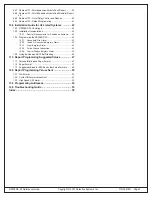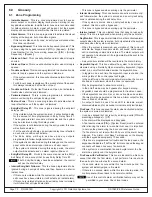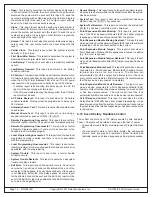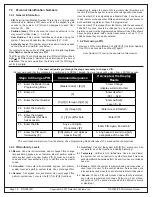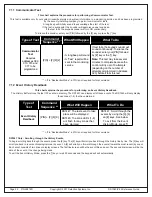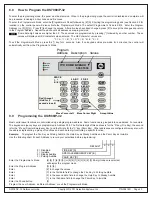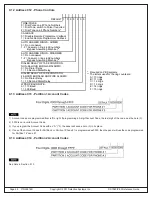
DS7080iP-32 Reference Guide Copyright © 2001 Detection Systems, Inc. P/N 39818D Page 13
6.10 Phone Number General Control
Programming
• Enable Remote Programmer Callback: If programmed, when
the remote programmer tries to initiate a session with the panel,
the panel will hang up and call the remote programmer phone
number.
- This ensures the correct remote programmer is initiating the
call.
• Dial Pulse on all Phone Numbers: If programmed, the panel
will dial to phone number 1, 2, and the remote programmer phone
number 3 using the pulse format.
• Dial Tone on all Phone Numbers: If programmed, the panel will
dial to phone number 1, 2, and the remote programmer phone
number 3 using the tone format.
When dialing through PBX systems, program the phone
control as tone dial only.
• Switch to Pulse: If programmed, the control panel will try to dial
the first digit in tone dial and check to see if the dial tone has
been broken. If it has not been broken, it will try to dial again
using pulse dial.
Do not use this setting for PBX systems.
• Dialer Delay: A Dialer Delay of 15 seconds can be added when
reporting burglar alarms, 24-hour burglar alarms, and fire alarms.
- This delay will help to prevent false alarm reports by giving the
user 15 seconds to disarm the system before a report is sent.
6.11 Phone Answering Programming
• Phone Answering Programming: The control panel can be
programmed to answer the phone after a selected number of rings
for remote programming access. It can also be programmed to
answer the phone after a different number of rings when in armed
or disarmed states. This feature can also be used to call the panel
location and determine its arming state.
• Answering Machine Bypass: This feature allows the control
panel to answer incoming calls when answering machines are
used.
- If the line rings, stops ringing, then rings again within one minute,
the panel will seize the phone line on the first ring.
- To disable this feature, program the control panel to answer on
an even number of rings.
6.12 System Timers
• Entry and Exit Delay Timers are programmed in 5 second
increments up to 250 seconds.
- Example: To obtain an exit delay time of 45 seconds, the
program address must be programmed as 0 4 5.
• Bell Cut-off Timers are programmed from 0 to 99 minutes.
- Programming a Bell Cut-off timer for 0 minutes will result in no
time-out for that output.
- If the output is activated, it will remain activated until it is silenced
from a keypad.
• Automatic Test Reports may be set any time of day and for any
day of the week.
- The time that this report is sent is programmed in real time
(military time, see Address 024 and Address 025).
6.13 Force Arming Programming
• Force Arming: If programmed, allows violated zones to be force
armed.
- When force arming, the user must enter the usual arming
command followed by the [Bypass] key. This automatically
bypasses zones that are violated and programmed as
bypassable.
- Fire zones, keyswitch zones, and non-bypassable zones can
not be force armed.
- Not available in UL Listed systems.
6.14 Report Programming
• Reports: For pulse formats, reports are programmed by entering
data in the reporting (left) and extended (right) digits. The report
will send the data programmed for each event. For SIA and Contact
ID, the report formats are fixed and may be activated by placing a
1 in the (left) reporting digit.
- To disable a report, enter a 0 in the reporting digit.
Exception: In Pager Format, 0 may be a valid reporting digit.
See Section 11.2 Pager Format.
- To send the Man Number along with Open and Close reports,
program an "F" (enter [*] [5]) in the extended digit.
• Zone Alarm: An alarm report is sent when a zone alarm occurs.
Program this report for any zones you wish to send an alarm
report for. For local zones (no reports), do not program an alarm
report. The zone number will automatically be sent for this report
in SIA or Contact ID format.
• Zone Alarm Restoral: This report is sent when the zone alarm
is cleared. The zone number will automatically be sent for this
report in SIA or Contact ID format.
• Zone Bypass: This report is sent when a zone bypass occurs. A
report for a non-24 hour zone is sent at arming with the close
report. For a 24 hour zone, the bypass report is sent when the
zone is manually bypassed. When the zone is force bypassed the
bypass report is sent with the partial close report. When a zone is
custom armed a bypass report for a 24 hour and non-24 hour
zone is sent.
• Zone Bypass Restoral: This report is sent when the bypassed
zone is restored. A bypass restoral report for a non-24 hour zone
is sent when the zone physically restores. For a 24 hour zone the
bypass restoral report is sent when the zone is manually restored.
When a force-armed zone is restored a zone restoral report is
sent. When a zone that was custom armed is restored and
disarmed the bypass restoral report is sent for 24 and non-24
hour zones.
• Zone Trouble: This report is sent when a zone trouble condition
occurs. The zone number will automatically be sent for this report
in SIA or Contact ID format.
• Zone Trouble Restoral: This report is sent when the zone trouble
condition is cleared. The zone number will automatically be sent
for this report in SIA or Contact ID format.
• Keypad Fire Alarm: This report is sent when a fire alarm has
been activated using the “A” emergency key.
• Keypad Fire Restoral: This report is sent when a keypad fire
alarm has been restored using the [System Reset] command.
• Keypad Emergency Alarm: This repor t is sent when an
emergency alarm has been activated using the “B” emergency
key.
• Keypad Panic: This report is sent when an emergency alarm
has been activated using the “C” emergency key.



